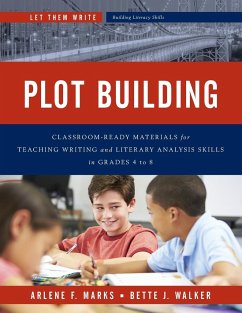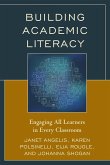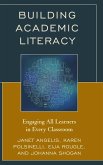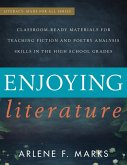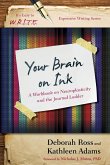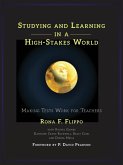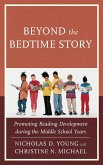Arlene F. Marks, Bette J. Walker
Plot Building
Classroom Ready Materials for Teaching Writing and Literary Analysis Skills in Grades 4 to 8
Arlene F. Marks, Bette J. Walker
Plot Building
Classroom Ready Materials for Teaching Writing and Literary Analysis Skills in Grades 4 to 8
- Broschiertes Buch
- Merkliste
- Auf die Merkliste
- Bewerten Bewerten
- Teilen
- Produkt teilen
- Produkterinnerung
- Produkterinnerung
Let Them Write: Plot Building focuses on conflict, suspense and narrative structure. Students practice first-drafting, editing, polishing and sharing original scenes and stories built around these three important elements of storytelling.
Andere Kunden interessierten sich auch für
![Building Academic Literacy Building Academic Literacy]() Janet I. AngelisBuilding Academic Literacy43,99 €
Janet I. AngelisBuilding Academic Literacy43,99 €![Building Academic Literacy Building Academic Literacy]() Janet I. AngelisBuilding Academic Literacy80,99 €
Janet I. AngelisBuilding Academic Literacy80,99 €![Wordsmithing Wordsmithing]() Arlene F. MarksWordsmithing81,99 €
Arlene F. MarksWordsmithing81,99 €![Enjoying Literature Enjoying Literature]() Arlene F. MarksEnjoying Literature80,99 €
Arlene F. MarksEnjoying Literature80,99 €![Your Brain on Ink Your Brain on Ink]() Kathleen AdamsYour Brain on Ink44,99 €
Kathleen AdamsYour Brain on Ink44,99 €![Studying and Learning in a High-Stakes World Studying and Learning in a High-Stakes World]() Rona F. FlippoStudying and Learning in a High-Stakes World55,99 €
Rona F. FlippoStudying and Learning in a High-Stakes World55,99 €![Beyond the Bedtime Story Beyond the Bedtime Story]() Nicholas D. YoungBeyond the Bedtime Story74,99 €
Nicholas D. YoungBeyond the Bedtime Story74,99 €-
-
-
Let Them Write: Plot Building focuses on conflict, suspense and narrative structure. Students practice first-drafting, editing, polishing and sharing original scenes and stories built around these three important elements of storytelling.
Produktdetails
- Produktdetails
- Verlag: Rowman & Littlefield Publishers
- Seitenzahl: 182
- Erscheinungstermin: 16. Juli 2015
- Englisch
- Abmessung: 280mm x 216mm x 10mm
- Gewicht: 474g
- ISBN-13: 9781475818383
- ISBN-10: 1475818386
- Artikelnr.: 42373528
- Herstellerkennzeichnung
- Libri GmbH
- Europaallee 1
- 36244 Bad Hersfeld
- gpsr@libri.de
- Verlag: Rowman & Littlefield Publishers
- Seitenzahl: 182
- Erscheinungstermin: 16. Juli 2015
- Englisch
- Abmessung: 280mm x 216mm x 10mm
- Gewicht: 474g
- ISBN-13: 9781475818383
- ISBN-10: 1475818386
- Artikelnr.: 42373528
- Herstellerkennzeichnung
- Libri GmbH
- Europaallee 1
- 36244 Bad Hersfeld
- gpsr@libri.de
Born and raised in Toronto, Arlene F. Marks found her storytelling muse at the age of 6, and she has been writing and sharing her imaginative tales ever since. She is also a retired educator and veteran teacher of the craft, having authored two literacy programs for the classroom, as well as From First Word to Last: The Craft of Writing Popular Fiction. During her life, she has worked as everything from a travel agent to a fashion consultant. However, her first love and current obsession is writing speculative fiction.Arlene lives with her husband on the shore of beautiful Nottawasaga Bay. She spends an inordinate amount of time following her characters around the universes in her mind, but she can be lured away from them by dark chocolate... and interesting owls to add to her collection. www.thewritersnest.ca
INTRODUCTION TO LET THEM WRITE
Messages from the authors
How to implement this program
The aims and objectives of this program
How to implement Let Them Read
Writing a literary essay
The aims and objectives of Let Them Read
Setting up a writer-friendly classroom
Authors need a writing plan
Publishing students' work
NCCS Anchors addressed
SECTION 1: SUSPENSE
SKILL 1: USING SETTINGS TO BUILD SUSPENSE
As students practice choosing and describing settings in ways that build
suspense, they may become more observant about their own surroundings.
Reproducibles/Media:PBR 1-SUSPENSEFUL SETTINGS Worksheet
PBR 2-SUSPENSEFUL SETTINGS HAVE Worksheet
SKILL 2: CREATING SUSPENSE WITH TIME Race Between Hero and Villain
As young authors practice describing a race between the protagonist and
antagonist of a story, they may come to appreciate the suspense inherent in
any kind of race.
Reproducibles/Media:PBR 3-WHO WILL WIN THE RACE?
PBR 4-RACE BETWEEN THE HERO AND THE VILLAIN
SKILL 3: CREATING SUSPENSE WITH TIME Race Against the Clock
As students practice describing a character rushing to beat a deadline,
they may come to appreciate the suspense inherent in any kind of race.
Reproducibles/Media:PBR 5-RACE AGAINST THE CLOCK Worksheet
SKILL 4: CREATING SUSPENSE WITH TIME Near Misses
Young authors will practice using timing to create and intensify suspense
in a story. In the process, they may come to understand the role played by
timing in determining the course of events in real life.
Reproducibles/Media:PBR 6-TIMING CREATES SUSPENSE
SKILL 5: MAXIMIZING SUSPENSE BY TEASING
Young authors will practice building maximum suspense by creating a
'knowledge gap' between the reader and the main character. In the process,
they will come to appreciate the story-telling skill shown by the authors
they are studying in class.
Reproducibles/Media:PBR 7-CREATING MAXIMUM SUSPENSE
PBR 8-SUSPENSE BY TEASING Worksheet
SKILL 6: MAINTAINING SUSPENSE BY KEEPING THE BALANCE OF POWER
Student authors will practice keeping the outcome of the conflict between
protagonist and antagonist in doubt by ensuring that their respective
strengths remain equal throughout the story. In the process, students may
come to appreciate the value of qualities other than physical strength in
determining a winner.
Reproducibles/Media:PBR 9-MAINTAINING THE BALANCE OF POWERPBR 10-THE
BALANCE OF POWER
SKILL 7: DEVELOPING THE SUSPENSE IN A SITUATION
As students practice using a variety of suspense-building techniques to
make a story exciting, they may come to appreciate the potential for
suspense in every situation.
Reproducibles/Media:PBR 11-SUSPENSEFUL STORY SITUATIONS
PBR 12-SUSPENSE BUILDING TECHNIQUES
SECTION 2: DRAMATIC CONFLICT
SKILL 1: UNDERSTANDING DRAMATIC CONFLICT
By learning to identify the presence of dramatic conflict in a story,
student authors will be better able to know whether it is present in their
own writing.
Reproducibles/Media: PBR 13-DRAMATIC CONFLICT Worksheet
SKILL 2: BUILDING DRAMATIC CONFLICT
Young authors practice building conflict as a first step in developing a
story. In the process, they may come to understand the fundamental role
played by dramatic conflict in real-life narratives as well.
Reproducibles/Media:PBR 14-DRAMATIC CONFLICT B Sheet
SKILL 3: CREATING TEXTURE WITH THREE KINDS OF CONFLICT
As young authors practice including more than one antagonist in a story,
they will become more aware of the role played by dramatic conflict in
creating texture, deepening suspense, and increasing reader engagement.
Reproducibles/Media: PBR 15-THREE TYPES OF CONFLICT
SKILL 4: UNDERSTANDING STORY GOALS AND SCENE GOALS
As student authors practice identifying their main characters' goals, they
will learn how to plan and organize a complete story with more confidence.
In the process, they may come to understand how having short-term and
long-term goals can help them to plan the narrative of their own lives.
Reproducibles/Media: PBR 16-STORY GOAL AND SCENE GOALS
PBR 17-SCENES TAKE SHAPE
SECTION 3: STORY STRUCTURE
SKILL 1: UNDERSTANDING STORY STRUCTURE A Change Story
As young authors practice organizing a story around a main character who
must adapt to a major upheaval in his or her life, they should begin to
understand that people are constantly being changed by their experiences.
Reproducibles/Media:PBR 18-STORY OUTLINE Worksheet
PBR 19-A CHANGE STORY Worksheet
SKILL 2: UNDERSTANDING STORY STRUCTURE A Problem Story
As student authors practice organizing a story around a character
attempting to resolve a problem in his or her life, they should begin to
understand that people learn and grow from the experience of
problem-solving, whether or not an attempt is successful.
Reproducibles/Media:PBR 20-A PROBLEM STORY Worksheet
SKILL 3: UNDERSTANDING SCENE STRUCTURE
A grasp of scene-building is fundamental to good story-writing. As students
practice constructing and ordering scenes, they may also come to realize
how powerful cause and effect are in determining the sequence of events of
real life.
Reproducibles/Media: PBR 21-STRUCTURE OF A SCENE Worksheet A
SKILL 4: LINKING SCENES
Student authors practice creating coherence in a story by making individual
scenes flow together into a seamless narrative. In the process, they may
begin to appreciate the importance of this skill in making any type of
writing more engaging for the reader.
Reproducibles/Media: PBR 22-OUTLINE YOUR SCENES Chart
SKILL 5: WRITING OPENING SCENES
As students learn about and practice writing interesting and engaging
beginnings to stories, they may come to understand how important first
impressions are in real life as well as in literature.
Reproducibles/Media:PBR 23-SETTINGS AND PURPOSES
SKILL 6: WRITING CLOSING SCENES The Climax and Denouement
Student authors will learn about and practice making the end of a story
emotionally satisfying to the reader. In the process, they may come to
realize how important closure is in real life as well.
Reproducibles/Media:PBR 24-REAL GOALS AND STATED GOALS
PBR 25-CHARACTERS AND STATED GOALS
Messages from the authors
How to implement this program
The aims and objectives of this program
How to implement Let Them Read
Writing a literary essay
The aims and objectives of Let Them Read
Setting up a writer-friendly classroom
Authors need a writing plan
Publishing students' work
NCCS Anchors addressed
SECTION 1: SUSPENSE
SKILL 1: USING SETTINGS TO BUILD SUSPENSE
As students practice choosing and describing settings in ways that build
suspense, they may become more observant about their own surroundings.
Reproducibles/Media:PBR 1-SUSPENSEFUL SETTINGS Worksheet
PBR 2-SUSPENSEFUL SETTINGS HAVE Worksheet
SKILL 2: CREATING SUSPENSE WITH TIME Race Between Hero and Villain
As young authors practice describing a race between the protagonist and
antagonist of a story, they may come to appreciate the suspense inherent in
any kind of race.
Reproducibles/Media:PBR 3-WHO WILL WIN THE RACE?
PBR 4-RACE BETWEEN THE HERO AND THE VILLAIN
SKILL 3: CREATING SUSPENSE WITH TIME Race Against the Clock
As students practice describing a character rushing to beat a deadline,
they may come to appreciate the suspense inherent in any kind of race.
Reproducibles/Media:PBR 5-RACE AGAINST THE CLOCK Worksheet
SKILL 4: CREATING SUSPENSE WITH TIME Near Misses
Young authors will practice using timing to create and intensify suspense
in a story. In the process, they may come to understand the role played by
timing in determining the course of events in real life.
Reproducibles/Media:PBR 6-TIMING CREATES SUSPENSE
SKILL 5: MAXIMIZING SUSPENSE BY TEASING
Young authors will practice building maximum suspense by creating a
'knowledge gap' between the reader and the main character. In the process,
they will come to appreciate the story-telling skill shown by the authors
they are studying in class.
Reproducibles/Media:PBR 7-CREATING MAXIMUM SUSPENSE
PBR 8-SUSPENSE BY TEASING Worksheet
SKILL 6: MAINTAINING SUSPENSE BY KEEPING THE BALANCE OF POWER
Student authors will practice keeping the outcome of the conflict between
protagonist and antagonist in doubt by ensuring that their respective
strengths remain equal throughout the story. In the process, students may
come to appreciate the value of qualities other than physical strength in
determining a winner.
Reproducibles/Media:PBR 9-MAINTAINING THE BALANCE OF POWERPBR 10-THE
BALANCE OF POWER
SKILL 7: DEVELOPING THE SUSPENSE IN A SITUATION
As students practice using a variety of suspense-building techniques to
make a story exciting, they may come to appreciate the potential for
suspense in every situation.
Reproducibles/Media:PBR 11-SUSPENSEFUL STORY SITUATIONS
PBR 12-SUSPENSE BUILDING TECHNIQUES
SECTION 2: DRAMATIC CONFLICT
SKILL 1: UNDERSTANDING DRAMATIC CONFLICT
By learning to identify the presence of dramatic conflict in a story,
student authors will be better able to know whether it is present in their
own writing.
Reproducibles/Media: PBR 13-DRAMATIC CONFLICT Worksheet
SKILL 2: BUILDING DRAMATIC CONFLICT
Young authors practice building conflict as a first step in developing a
story. In the process, they may come to understand the fundamental role
played by dramatic conflict in real-life narratives as well.
Reproducibles/Media:PBR 14-DRAMATIC CONFLICT B Sheet
SKILL 3: CREATING TEXTURE WITH THREE KINDS OF CONFLICT
As young authors practice including more than one antagonist in a story,
they will become more aware of the role played by dramatic conflict in
creating texture, deepening suspense, and increasing reader engagement.
Reproducibles/Media: PBR 15-THREE TYPES OF CONFLICT
SKILL 4: UNDERSTANDING STORY GOALS AND SCENE GOALS
As student authors practice identifying their main characters' goals, they
will learn how to plan and organize a complete story with more confidence.
In the process, they may come to understand how having short-term and
long-term goals can help them to plan the narrative of their own lives.
Reproducibles/Media: PBR 16-STORY GOAL AND SCENE GOALS
PBR 17-SCENES TAKE SHAPE
SECTION 3: STORY STRUCTURE
SKILL 1: UNDERSTANDING STORY STRUCTURE A Change Story
As young authors practice organizing a story around a main character who
must adapt to a major upheaval in his or her life, they should begin to
understand that people are constantly being changed by their experiences.
Reproducibles/Media:PBR 18-STORY OUTLINE Worksheet
PBR 19-A CHANGE STORY Worksheet
SKILL 2: UNDERSTANDING STORY STRUCTURE A Problem Story
As student authors practice organizing a story around a character
attempting to resolve a problem in his or her life, they should begin to
understand that people learn and grow from the experience of
problem-solving, whether or not an attempt is successful.
Reproducibles/Media:PBR 20-A PROBLEM STORY Worksheet
SKILL 3: UNDERSTANDING SCENE STRUCTURE
A grasp of scene-building is fundamental to good story-writing. As students
practice constructing and ordering scenes, they may also come to realize
how powerful cause and effect are in determining the sequence of events of
real life.
Reproducibles/Media: PBR 21-STRUCTURE OF A SCENE Worksheet A
SKILL 4: LINKING SCENES
Student authors practice creating coherence in a story by making individual
scenes flow together into a seamless narrative. In the process, they may
begin to appreciate the importance of this skill in making any type of
writing more engaging for the reader.
Reproducibles/Media: PBR 22-OUTLINE YOUR SCENES Chart
SKILL 5: WRITING OPENING SCENES
As students learn about and practice writing interesting and engaging
beginnings to stories, they may come to understand how important first
impressions are in real life as well as in literature.
Reproducibles/Media:PBR 23-SETTINGS AND PURPOSES
SKILL 6: WRITING CLOSING SCENES The Climax and Denouement
Student authors will learn about and practice making the end of a story
emotionally satisfying to the reader. In the process, they may come to
realize how important closure is in real life as well.
Reproducibles/Media:PBR 24-REAL GOALS AND STATED GOALS
PBR 25-CHARACTERS AND STATED GOALS
INTRODUCTION TO LET THEM WRITE
Messages from the authors
How to implement this program
The aims and objectives of this program
How to implement Let Them Read
Writing a literary essay
The aims and objectives of Let Them Read
Setting up a writer-friendly classroom
Authors need a writing plan
Publishing students' work
NCCS Anchors addressed
SECTION 1: SUSPENSE
SKILL 1: USING SETTINGS TO BUILD SUSPENSE
As students practice choosing and describing settings in ways that build
suspense, they may become more observant about their own surroundings.
Reproducibles/Media:PBR 1-SUSPENSEFUL SETTINGS Worksheet
PBR 2-SUSPENSEFUL SETTINGS HAVE Worksheet
SKILL 2: CREATING SUSPENSE WITH TIME Race Between Hero and Villain
As young authors practice describing a race between the protagonist and
antagonist of a story, they may come to appreciate the suspense inherent in
any kind of race.
Reproducibles/Media:PBR 3-WHO WILL WIN THE RACE?
PBR 4-RACE BETWEEN THE HERO AND THE VILLAIN
SKILL 3: CREATING SUSPENSE WITH TIME Race Against the Clock
As students practice describing a character rushing to beat a deadline,
they may come to appreciate the suspense inherent in any kind of race.
Reproducibles/Media:PBR 5-RACE AGAINST THE CLOCK Worksheet
SKILL 4: CREATING SUSPENSE WITH TIME Near Misses
Young authors will practice using timing to create and intensify suspense
in a story. In the process, they may come to understand the role played by
timing in determining the course of events in real life.
Reproducibles/Media:PBR 6-TIMING CREATES SUSPENSE
SKILL 5: MAXIMIZING SUSPENSE BY TEASING
Young authors will practice building maximum suspense by creating a
'knowledge gap' between the reader and the main character. In the process,
they will come to appreciate the story-telling skill shown by the authors
they are studying in class.
Reproducibles/Media:PBR 7-CREATING MAXIMUM SUSPENSE
PBR 8-SUSPENSE BY TEASING Worksheet
SKILL 6: MAINTAINING SUSPENSE BY KEEPING THE BALANCE OF POWER
Student authors will practice keeping the outcome of the conflict between
protagonist and antagonist in doubt by ensuring that their respective
strengths remain equal throughout the story. In the process, students may
come to appreciate the value of qualities other than physical strength in
determining a winner.
Reproducibles/Media:PBR 9-MAINTAINING THE BALANCE OF POWERPBR 10-THE
BALANCE OF POWER
SKILL 7: DEVELOPING THE SUSPENSE IN A SITUATION
As students practice using a variety of suspense-building techniques to
make a story exciting, they may come to appreciate the potential for
suspense in every situation.
Reproducibles/Media:PBR 11-SUSPENSEFUL STORY SITUATIONS
PBR 12-SUSPENSE BUILDING TECHNIQUES
SECTION 2: DRAMATIC CONFLICT
SKILL 1: UNDERSTANDING DRAMATIC CONFLICT
By learning to identify the presence of dramatic conflict in a story,
student authors will be better able to know whether it is present in their
own writing.
Reproducibles/Media: PBR 13-DRAMATIC CONFLICT Worksheet
SKILL 2: BUILDING DRAMATIC CONFLICT
Young authors practice building conflict as a first step in developing a
story. In the process, they may come to understand the fundamental role
played by dramatic conflict in real-life narratives as well.
Reproducibles/Media:PBR 14-DRAMATIC CONFLICT B Sheet
SKILL 3: CREATING TEXTURE WITH THREE KINDS OF CONFLICT
As young authors practice including more than one antagonist in a story,
they will become more aware of the role played by dramatic conflict in
creating texture, deepening suspense, and increasing reader engagement.
Reproducibles/Media: PBR 15-THREE TYPES OF CONFLICT
SKILL 4: UNDERSTANDING STORY GOALS AND SCENE GOALS
As student authors practice identifying their main characters' goals, they
will learn how to plan and organize a complete story with more confidence.
In the process, they may come to understand how having short-term and
long-term goals can help them to plan the narrative of their own lives.
Reproducibles/Media: PBR 16-STORY GOAL AND SCENE GOALS
PBR 17-SCENES TAKE SHAPE
SECTION 3: STORY STRUCTURE
SKILL 1: UNDERSTANDING STORY STRUCTURE A Change Story
As young authors practice organizing a story around a main character who
must adapt to a major upheaval in his or her life, they should begin to
understand that people are constantly being changed by their experiences.
Reproducibles/Media:PBR 18-STORY OUTLINE Worksheet
PBR 19-A CHANGE STORY Worksheet
SKILL 2: UNDERSTANDING STORY STRUCTURE A Problem Story
As student authors practice organizing a story around a character
attempting to resolve a problem in his or her life, they should begin to
understand that people learn and grow from the experience of
problem-solving, whether or not an attempt is successful.
Reproducibles/Media:PBR 20-A PROBLEM STORY Worksheet
SKILL 3: UNDERSTANDING SCENE STRUCTURE
A grasp of scene-building is fundamental to good story-writing. As students
practice constructing and ordering scenes, they may also come to realize
how powerful cause and effect are in determining the sequence of events of
real life.
Reproducibles/Media: PBR 21-STRUCTURE OF A SCENE Worksheet A
SKILL 4: LINKING SCENES
Student authors practice creating coherence in a story by making individual
scenes flow together into a seamless narrative. In the process, they may
begin to appreciate the importance of this skill in making any type of
writing more engaging for the reader.
Reproducibles/Media: PBR 22-OUTLINE YOUR SCENES Chart
SKILL 5: WRITING OPENING SCENES
As students learn about and practice writing interesting and engaging
beginnings to stories, they may come to understand how important first
impressions are in real life as well as in literature.
Reproducibles/Media:PBR 23-SETTINGS AND PURPOSES
SKILL 6: WRITING CLOSING SCENES The Climax and Denouement
Student authors will learn about and practice making the end of a story
emotionally satisfying to the reader. In the process, they may come to
realize how important closure is in real life as well.
Reproducibles/Media:PBR 24-REAL GOALS AND STATED GOALS
PBR 25-CHARACTERS AND STATED GOALS
Messages from the authors
How to implement this program
The aims and objectives of this program
How to implement Let Them Read
Writing a literary essay
The aims and objectives of Let Them Read
Setting up a writer-friendly classroom
Authors need a writing plan
Publishing students' work
NCCS Anchors addressed
SECTION 1: SUSPENSE
SKILL 1: USING SETTINGS TO BUILD SUSPENSE
As students practice choosing and describing settings in ways that build
suspense, they may become more observant about their own surroundings.
Reproducibles/Media:PBR 1-SUSPENSEFUL SETTINGS Worksheet
PBR 2-SUSPENSEFUL SETTINGS HAVE Worksheet
SKILL 2: CREATING SUSPENSE WITH TIME Race Between Hero and Villain
As young authors practice describing a race between the protagonist and
antagonist of a story, they may come to appreciate the suspense inherent in
any kind of race.
Reproducibles/Media:PBR 3-WHO WILL WIN THE RACE?
PBR 4-RACE BETWEEN THE HERO AND THE VILLAIN
SKILL 3: CREATING SUSPENSE WITH TIME Race Against the Clock
As students practice describing a character rushing to beat a deadline,
they may come to appreciate the suspense inherent in any kind of race.
Reproducibles/Media:PBR 5-RACE AGAINST THE CLOCK Worksheet
SKILL 4: CREATING SUSPENSE WITH TIME Near Misses
Young authors will practice using timing to create and intensify suspense
in a story. In the process, they may come to understand the role played by
timing in determining the course of events in real life.
Reproducibles/Media:PBR 6-TIMING CREATES SUSPENSE
SKILL 5: MAXIMIZING SUSPENSE BY TEASING
Young authors will practice building maximum suspense by creating a
'knowledge gap' between the reader and the main character. In the process,
they will come to appreciate the story-telling skill shown by the authors
they are studying in class.
Reproducibles/Media:PBR 7-CREATING MAXIMUM SUSPENSE
PBR 8-SUSPENSE BY TEASING Worksheet
SKILL 6: MAINTAINING SUSPENSE BY KEEPING THE BALANCE OF POWER
Student authors will practice keeping the outcome of the conflict between
protagonist and antagonist in doubt by ensuring that their respective
strengths remain equal throughout the story. In the process, students may
come to appreciate the value of qualities other than physical strength in
determining a winner.
Reproducibles/Media:PBR 9-MAINTAINING THE BALANCE OF POWERPBR 10-THE
BALANCE OF POWER
SKILL 7: DEVELOPING THE SUSPENSE IN A SITUATION
As students practice using a variety of suspense-building techniques to
make a story exciting, they may come to appreciate the potential for
suspense in every situation.
Reproducibles/Media:PBR 11-SUSPENSEFUL STORY SITUATIONS
PBR 12-SUSPENSE BUILDING TECHNIQUES
SECTION 2: DRAMATIC CONFLICT
SKILL 1: UNDERSTANDING DRAMATIC CONFLICT
By learning to identify the presence of dramatic conflict in a story,
student authors will be better able to know whether it is present in their
own writing.
Reproducibles/Media: PBR 13-DRAMATIC CONFLICT Worksheet
SKILL 2: BUILDING DRAMATIC CONFLICT
Young authors practice building conflict as a first step in developing a
story. In the process, they may come to understand the fundamental role
played by dramatic conflict in real-life narratives as well.
Reproducibles/Media:PBR 14-DRAMATIC CONFLICT B Sheet
SKILL 3: CREATING TEXTURE WITH THREE KINDS OF CONFLICT
As young authors practice including more than one antagonist in a story,
they will become more aware of the role played by dramatic conflict in
creating texture, deepening suspense, and increasing reader engagement.
Reproducibles/Media: PBR 15-THREE TYPES OF CONFLICT
SKILL 4: UNDERSTANDING STORY GOALS AND SCENE GOALS
As student authors practice identifying their main characters' goals, they
will learn how to plan and organize a complete story with more confidence.
In the process, they may come to understand how having short-term and
long-term goals can help them to plan the narrative of their own lives.
Reproducibles/Media: PBR 16-STORY GOAL AND SCENE GOALS
PBR 17-SCENES TAKE SHAPE
SECTION 3: STORY STRUCTURE
SKILL 1: UNDERSTANDING STORY STRUCTURE A Change Story
As young authors practice organizing a story around a main character who
must adapt to a major upheaval in his or her life, they should begin to
understand that people are constantly being changed by their experiences.
Reproducibles/Media:PBR 18-STORY OUTLINE Worksheet
PBR 19-A CHANGE STORY Worksheet
SKILL 2: UNDERSTANDING STORY STRUCTURE A Problem Story
As student authors practice organizing a story around a character
attempting to resolve a problem in his or her life, they should begin to
understand that people learn and grow from the experience of
problem-solving, whether or not an attempt is successful.
Reproducibles/Media:PBR 20-A PROBLEM STORY Worksheet
SKILL 3: UNDERSTANDING SCENE STRUCTURE
A grasp of scene-building is fundamental to good story-writing. As students
practice constructing and ordering scenes, they may also come to realize
how powerful cause and effect are in determining the sequence of events of
real life.
Reproducibles/Media: PBR 21-STRUCTURE OF A SCENE Worksheet A
SKILL 4: LINKING SCENES
Student authors practice creating coherence in a story by making individual
scenes flow together into a seamless narrative. In the process, they may
begin to appreciate the importance of this skill in making any type of
writing more engaging for the reader.
Reproducibles/Media: PBR 22-OUTLINE YOUR SCENES Chart
SKILL 5: WRITING OPENING SCENES
As students learn about and practice writing interesting and engaging
beginnings to stories, they may come to understand how important first
impressions are in real life as well as in literature.
Reproducibles/Media:PBR 23-SETTINGS AND PURPOSES
SKILL 6: WRITING CLOSING SCENES The Climax and Denouement
Student authors will learn about and practice making the end of a story
emotionally satisfying to the reader. In the process, they may come to
realize how important closure is in real life as well.
Reproducibles/Media:PBR 24-REAL GOALS AND STATED GOALS
PBR 25-CHARACTERS AND STATED GOALS

